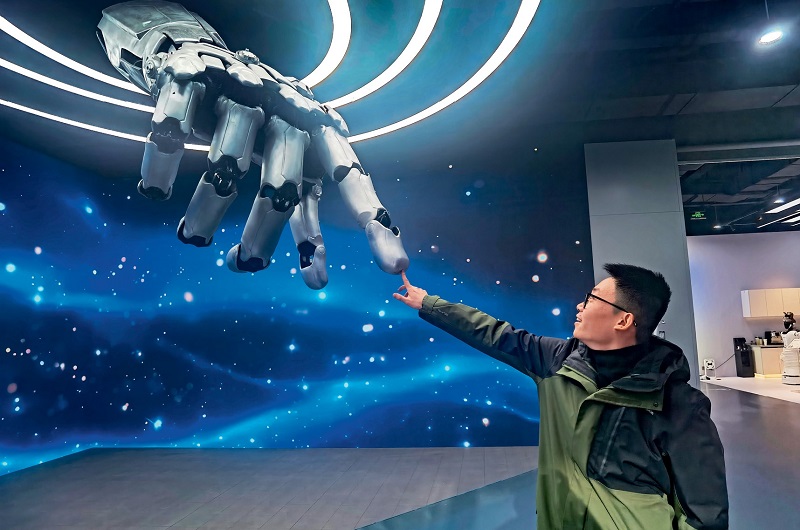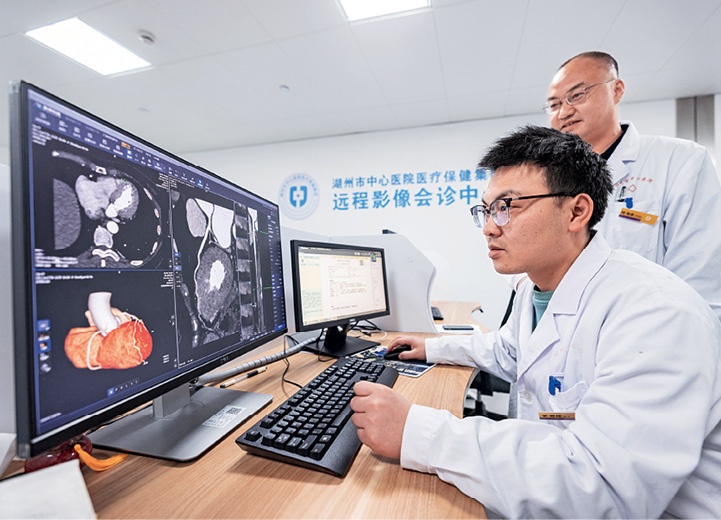
A visitor touches a robotic arm in a robot demonstration park in Beijing on February 24, 2025.
From chatbots capable of deep reasoning to humanoid robots equipped with intelligent “brains” for complex services, technological advancements continue to astonish us at an unprecedented pace. The rapid development of artificial intelligence (AI) is reshaping industries, enhancing productivity, and offering new possibilities for an intelligent life.
Stating that China attaches great importance to the development of the digital economy, Chinese President Xi Jinping has said the country continuously promotes the deep integration of digital technology and the real economy, coordinates advances in both the digital industry and the digital transformation of traditional industries, and accelerates building its cyberspace strength and a digital China.
An increasing number of Chinese companies have gained global recognition for their groundbreaking achievements in AI-driven innovation, following the introduction of the AI Plus initiative.
The initiative was first introduced in the 2024 Report on the Work of the Government, and subsequently reaffirmed at the 2024 Central Economic Work Conference and this year’s government work report as a key tool for fostering new quality productive forces.
This initiative aims to promote in-depth integration of AI and real economy by deepening the research and application of AI technology and injecting new impetus into China’s hi-tech industry and economic development.

The national AI emerging industrial cluster in Shanghai.
Blueprint for Development
In addition to emerging industries such as AI, the 2025 Report on the Work of the Government delivered by Chinese Premier Li Qiang on March 5 also mentions establishing a mechanism to increase funding for industries of the future and foster industries such as biomanufacturing, quantum technology, embodied AI, and 6G technology. AI plays a crucial role in these fields, acting as both a catalyst for growth and an enabler of technological breakthroughs.
At a press briefing following the opening of the third session of the 14th National People’s Congress, Chen Changsheng, deputy director of the State Council Research Office who participated in drafting the 2025 Report on the Work of the Government, said that the government is focusing on empowering industries with AI integration to accelerate industrial transformation and raise productivity, expanding AI-powered consumer products and scaling AI applications across multiple sectors.
Chen emphasized that in terms of terminal applications, the work report specifically mentions the rapid development of next-generation smart terminals, including intelligent connected vehicles, AI-powered smartphones, AI computers, and smart robots. AI terminals can benefit from China’s manufacturing strengths to accelerate commercial roll-out, enabling people to enjoy an intelligent lifestyle.
In response to the central government’s call to develop industries of the future, many provinces and municipalities have launched targeted policies to foster AI-driven development. Beijing has released a three-year action plan for embodied AI, aiming to cultivate an industry cluster worth hundreds of billions of yuan. Provinces such as Zhejiang and Guangdong have also unveiled strategic plans to support embedded AI and humanoid robotics, recognizing their potential in shaping a modern industrial ecosystem. They are expected to accelerate the integration of AI into various application scenarios.
Engine for Growth and Transformation
At the Beijing World of Robots, located in the robotics industrial park in Beijing’s Yizhuang, the vision of an intelligent future is coming to reality with all kinds of robots. With advanced AI capabilities, they are increasingly transitioning from industrial applications to domestic environments with human-like appearances and dexterous body and hand movements. These robots can interact seamlessly with AI-generated voices, bringing intelligent assistance to various aspects of everyday life.
Embedded AI, which integrates AI with physical entities such as robots, is emerging as a game-changing technology with limitless potential. Several Chinese companies have already made significant strides in this area. For instance, Unitree Robotics, known for its dancing robots showcased at CCTV’s Spring Festival Gala, exemplifies cutting-edge applications of embedded AI.
In industrial and agricultural settings, embedded AI can dramatically enhance operational efficiency, reduce costs, and enable precise management. For homes and healthcare sectors, it offers personalized and intelligent solutions, such as AI-powered smart home systems that have already been widely adopted. Additionally, autonomous driving technologies, though still under refinement and testing, represent another promising avenue for embedded AI.
One groundbreaking example of AI-driven robotics is the Galbot humanoid robot, showcased at the Beijing World of Robots in an unmanned pharmacy scenario. This innovative solution, jointly launched by Meituan Medicine and Galbot, represents the world’s first humanoid robot-powered smart pharmacy system. It made its debut at the China International Fair for Trade in Services in September 2024.
Designed for 24/7 autonomous operation, a Galbot robot can restock and retrieve items efficiently. It autonomously plans its route, navigates to the required item, and uses advanced AI-powered vision and grasping technology to complete the transaction. This cutting-edge technology exemplifies how AI is revolutionizing automated retail and healthcare services.

Two doctors make a diagnosis with the help of AI at the Huzhou Central Hospital, Zhejiang Province, on February 21, 2024.
Intelligent Life
With a powerful AI “brain” integrated into our smartphones, home appliances, and cars, these devices have evolved into reliable assistants, ready to respond to commands around the clock.
National People’s Congress Deputy Zhou Yunjie, who is also chairman of the Board and CEO of the Haier Group, stated that the smart home sector is undergoing a transformative shift from “single-device intelligence” to “integrated smart ecosystem,” with large AI models being the key driving force behind this change.
In 2023, Haier launched Three-Winged Bird HomeGPT, China’s first large-scale AI model for the smart home sector. With the ability to comprehensively understand users’ personalized needs, it enables seamless interconnectivity across all smart appliances, automatically optimizing their operation based on daily habits.
AI-powered smart home models are also expected to catalyze the rise of new consumer markets, such as home service robots, unlocking a trillion-yuan growth opportunity across the entire industrial chain.
Meanwhile, the automotive industry is also experiencing a rapid AI-driven transformation. By 2024, Level 2 (L2) advanced driver-assistance systems had become standard in newly released vehicles, while Level 3 (L3) conditional autonomous driving entered the pilot phase. Nine automakers are now participating in China’s L3 autonomous driving road test program, with cities like Beijing and Wuhan introducing regulatory frameworks to support L3 and higher levels of automation.
Autonomous driving is categorized into levels 0 to 5 by the Society of Automotive Engineers to define the extent to which a vehicle can perform driving tasks. Level 5 represents the highest level – vehicles can operate without any human oversight.
Autonomous mobility is also accelerating in scale. Baidu’s Apollo Go robotaxi service has expanded to 11 cities across China, completing over 8 million rides nationwide. This milestone marks a significant step toward the mainstream adoption of autonomous transportation, paving the way for a smarter, more efficient future of mobility.
China’s rapidly aging population presents both challenges and opportunities for the elderly care industry. AI-powered elderly care robots are emerging as a transformative force. It is expected that these robots will deliver high-quality care and inject momentum into the growing silver economy.
Smart elderly care robots integrate AI, the Internet of Things, bio-sensors, and flexible materials to provide intelligent assistance while also driving advancements in chips, sensors, and servo motors. Such innovation plays an important role in accelerating the development of new quality productive forces in China.
China has played a leading role in the development and standardization of elderly care robots, both through technological innovation and its active participation in international standard-setting bodies like the International Electrotechnical Commission, which recently released the world’s first international standard for elderly care robots. The standard focuses on the needs of seniors in connected home environment, covering various aspects of daily life and healthcare.
As AI technologies continue to evolve, China will further strengthen international cooperation in this field through technology transfer, talent development, and industrial innovation.